Massachusetts is the most populated state in the New England region of the United States. Most of the state is dominated by sand and silt from glacial outwash. Therefore, Massachusetts is well-known for its extensive salt marshes, mudflats, and sandy coastal shrublands.
During the early Paleozoic Era, Massachusetts was covered by a shallow sea, home to trilobites, brachiopods, and other marine mammals. Evidence suggests that the state was subject to glacial activity and residence to mastodons during the Pleistocene. Many other notable discoveries of megafauna mammals date back to this period, along with the remains of a couple of essential dinosaurs and their footprints.
Here are the 6 extinct animals that lived in Massachusetts:
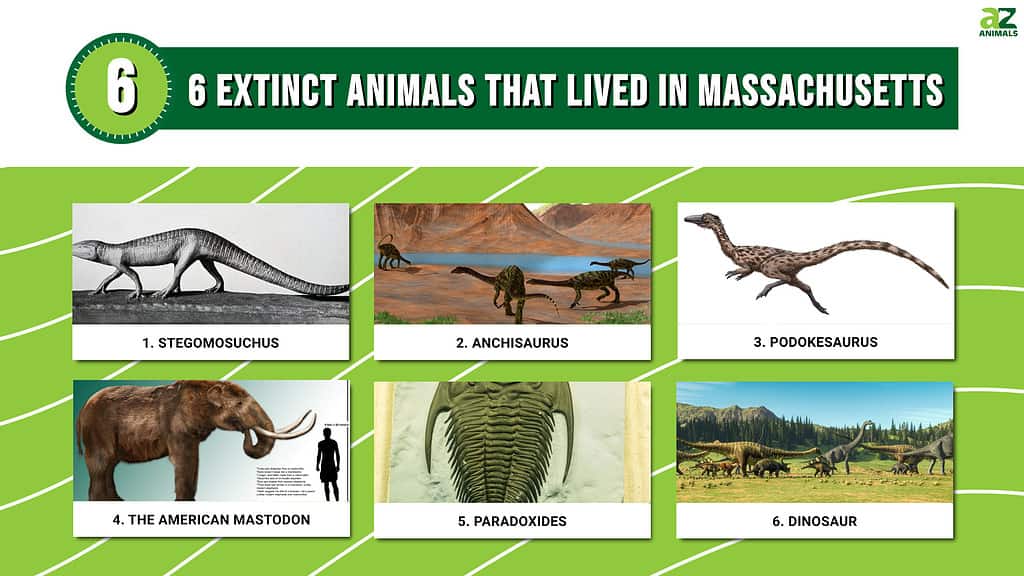
1. Stegomosuchus
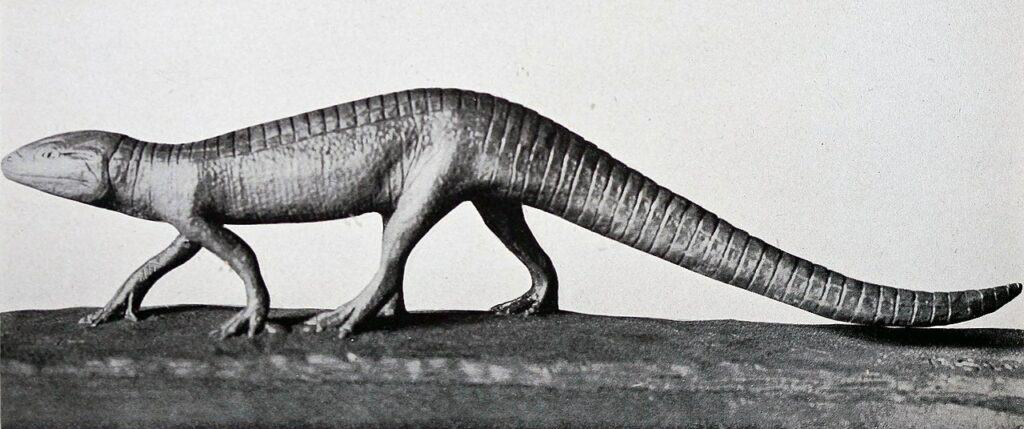
Stegomosuchus was a tiny protosuchian crocodylomorph of the early Jurassic period.
©Richard Swann Lull / public domain – License
| Stegomosuchus | |
|---|---|
| Kingdom | Animalia |
| Phylum | Chordata |
| Class | Sauropsida |
| Superorder | Crocodylomorpha |
| Suborder | Protosuchia |
| Genus | Stegomosuchus |
| Living period | Early Jurassic period |
Stegomosuchus was a tiny protosuchian crocodylomorph of the early Jurassic. It is known from the only fossil specimen discovered in Massachusetts sediments that date back to about 200 million to 190 million years ago.
At first, it was thought to be a species of Stegomus, an aetosaur (a type of armored herbivorous reptile). Scientists later described the Stegomosuchus as a close relative of Protusuchus and thus more comparable to the ancestry of crocodiles that evolved into the first dinosaurs during the late Triassic
2. Anchisaurus
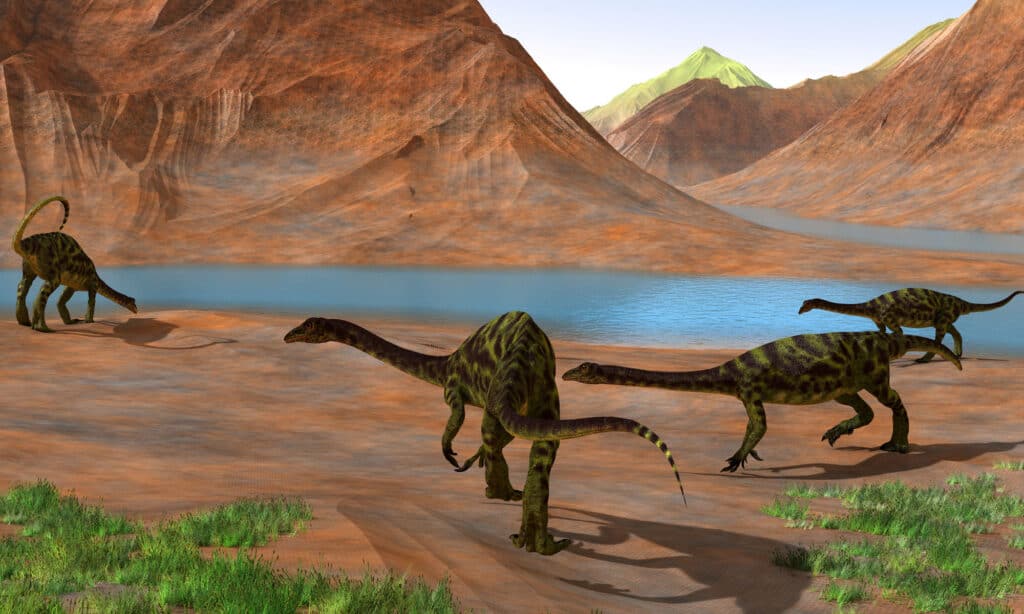
Anchisaurus remains are often mistaken for human bones.
©iStock.com/CoreyFord
| Anchisaurus | |
|---|---|
| Kingdom | Animalia |
| Phylum | Chordata |
| Clade | Dinosauria |
| Clade | Saurischia |
| Clade | Sauropodomorpha |
| Clade | Sauropodiformes |
| Clade | Anchisauria |
| Genus | Anchisaurus |
| Living period | The Early Jurassic Period |
Anchisaurus is an extinct basal sauropodomorph that lived during the early Jurassic. It was a small dinosaur, measuring approximately 6.6 to 16 feet long, and weighed about 60 pounds. For this reason, Anchisaurus remains are often mistaken for human bones.
Anchisaurus fossils have been discovered in the Connecticut River Valley, which spans Massachusetts and Connecticut. It was first classified as a prosauropod due to its primitive appearance. However, subsequent discoveries have cemented Anchisaurus’ credentials as a slender, bipedal plant-eating dinosaur ancestral to the giant titanosaurs and sauropods of the late Mesozoic Era.
3. Podokesaurus
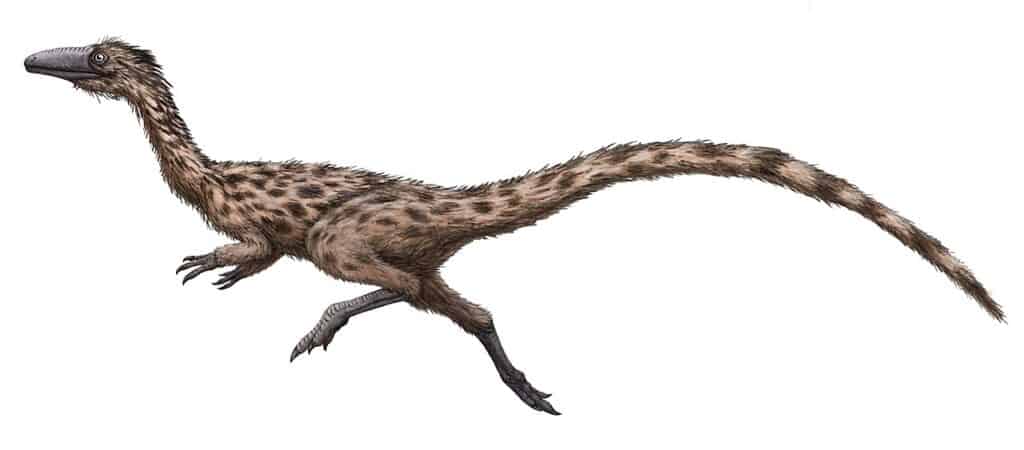
Podokesaurus is estimated to have weighed about 2 to 90 pounds.
©FunkMonk (Michael B. H.) / CC BY-SA 3.0 – License
| Podokesaurus | |
|---|---|
| Kingdom | Animalia |
| Phylum | Chordata |
| Clade | Dinosauria |
| Clade | Saurischia |
| Clade | Theropoda |
| Superfamily | Coelophysoidea |
| Genus | Podokesaurus |
| Species | Podokesaurus holyokensis |
| Living period | Early Jurassic period, between 201 million and 190 million years ago |
Podokesaurus was an extinct coelophysoid that inhabited the eastern parts of the United States during the Early Jurassic. The first Podokesaurus fossil was discovered near Mount Holyoke College in South Hadley, Massachusetts, in 1910. Unfortunately, the specimen was destroyed years ago in a museum fire.
Podokesaurus is estimated to have weighed about 2 to 90 pounds and measured approximately 3 feet long. It was slender, long-necked, and had sharp, recurved teeth. Its upper-arm bone (humerus) was small and delicate, while the femur was expanded at the back side of its lower end.
4. The American Mastodon
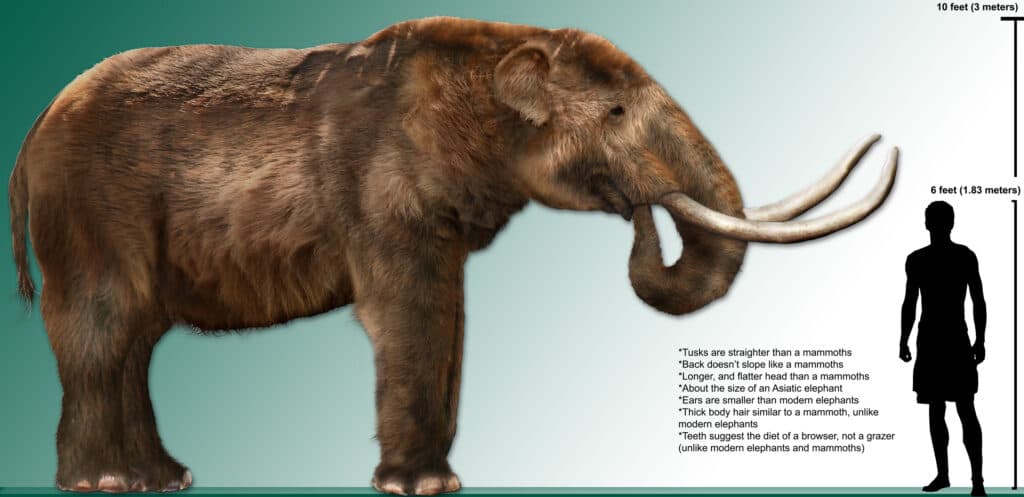
The American mastodon is a plus-sized mammal of the extinct genus Mammut.
©CC BY 3.0 / Dantheman9758 – License
| The American Mastodon | |
|---|---|
| Kingdom | Animalia |
| Phylum | Chordata |
| Class | Mammalia |
| Order | Proboscidea |
| Family | Mammutidae |
| Genus | Mammut |
| Living period | Late Miocene or late Pliocene – 11,000 years ago |
The American mastodon is a plus-sized mammal of the extinct genus Mammut. It lived in North and Central America during the late Miocene and late Pliocene until its extinction 11,000 years ago. The American mastodon disappeared at the end of the Pleistocene as part of a mass extinction that wiped out most megafauna mammals, believed to have been caused by climatic changes and over-exploitation by Paleo-Indians.
Mastodons were predominantly browsers and inhabited the forests. They were also social animals who preferred living in herds. They bore a striking resemblance to mammoths and elephants, though they were not closely related to either. Unlike mammoths, mastodons had more elongated bodies and shorter legs. They were also more heavily muscled like the modern Asian elephants. It’s estimated that mastodons weighed approximately 8.6 to 12 tons and grew up to 7 feet tall.
Mastodon’s discovery came when ancient proboscids weren’t as common as they are today. A group of workers digging a trench on a farm in Northborough, Massachusetts, found numerous fossilized teeth, tusks, and fragments in 1884. Paleontologists later identified the remains as belonging to an American mastodon.
5. Paradoxides
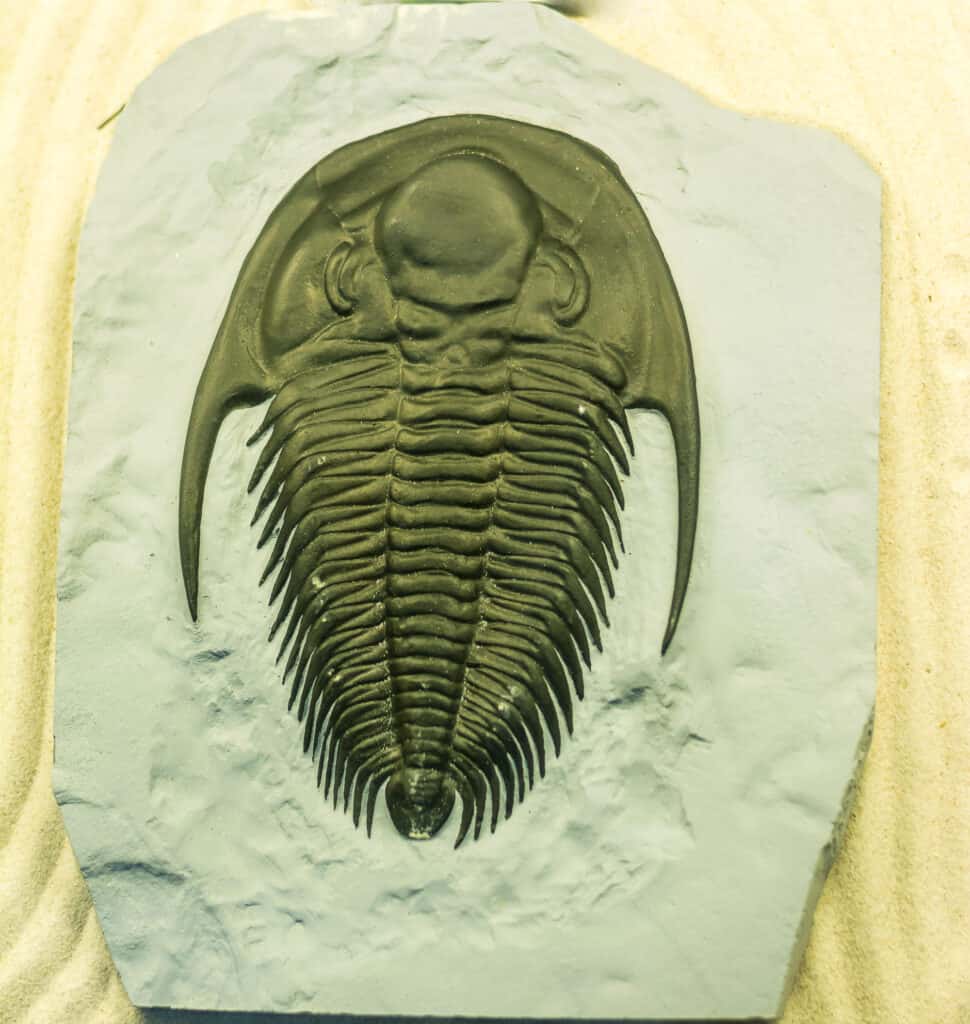
Paradoxides was an extinct genus of giant trilobites found all over the globe during the Middle Cambrian period.
©kriangkrainetnangrong/Shutterstock.com
| Paradoxides | |
|---|---|
| Kingdom | Animalia |
| Phylum | Arthropoda |
| Class | Trilobita |
| Order | Redlichiida |
| Family | Paradoxididae |
| Genus | Paradoxides |
| Living period | Middle Cambrian period |
Paradoxides was an extinct genus of giant trilobites found all over the globe during the Middle Cambrian Period. It had a semicircular cephalon with an elongated thorax composed of about 19-21 segments embellished with long, recurved spines.
Fossils of paradoxides have been found throughout the world, including in the US state of Massachusetts. Paleontologists believe there are still numerous Paradoxides fossils out there, and if you’re lucky, you can still discover a specimen on a trip to one of the state’s fossil formations.
6. Dinosaur
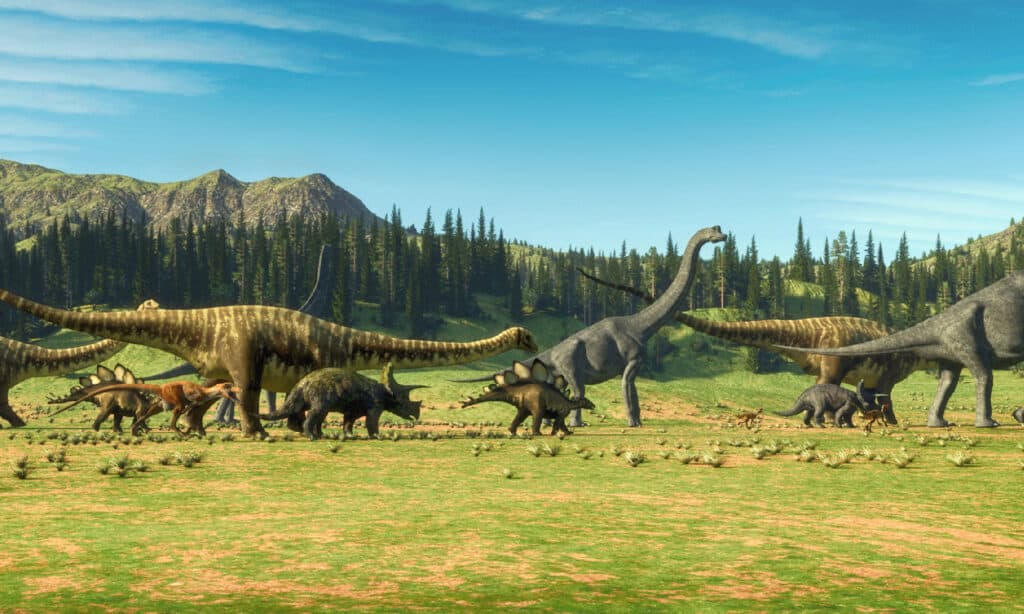
Dinosaurs dominated the entire Jurassic and Cretaceous periods.
©iStock.com/Orla
| Dinosaur | |
|---|---|
| Kingdom | Animalia |
| Phylum | Chordata |
| Clade | Dracohors |
| Clade | Dinosauria |
| Living period | Between 245 and 66 million years ago |
Dinosaur footprints are the Massachusetts state fossil. Unfortunately, scientists could not find the specific genera of dinosaurs that made these footprints. They only concluded that the tracks might have been made by sauropods or theropods (meat-eating dinosaurs).
The name ‘dinosaurs’ means ‘terrible lizard.’ They are a diverse group of reptiles that first appeared during the Triassic, about 243 million to 233.23 million years ago. They are among the megafauna mammals that survived the Triassic-Jurassic extinction event that occurred 201.3 million years ago. Dinosaurs dominated the entire Jurassic and Cretaceous Periods.
While most of the dinosaurs were ancestrally bipedal, others were quadrupedal species, and a few were able to shift between these stances. All the dinosaur groups had elaborate display structures like horns or crests and were also large-bodied. The sauropods were among the largest groups, having been estimated to reach lengths of up to 130 feet and heights of 59 feet.
The photo featured at the top of this post is © Liliya Butenko/Shutterstock.com
Thank you for reading! Have some feedback for us? Contact the AZ Animals editorial team.






